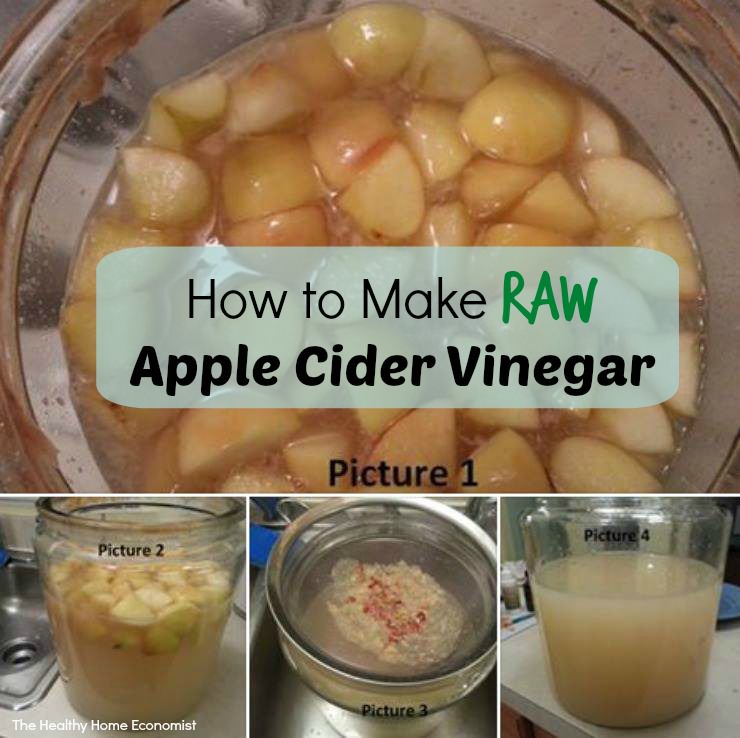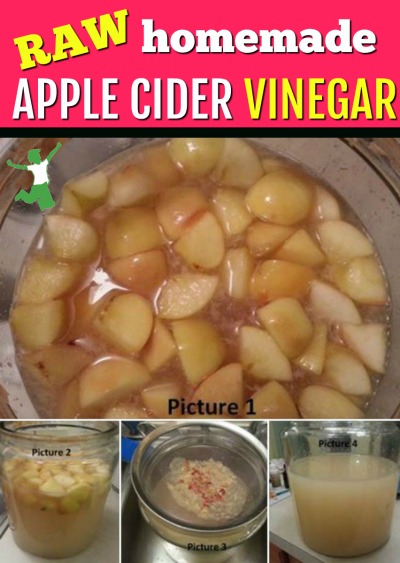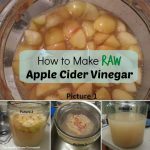How and why to make apple cider vinegar that is raw, enzyme and probiotic-rich for all your detoxification, cooking, and medicinal needs. This recipe uses raw honey, which makes the final result even more healthful and potent.
It’s apple season in many parts of North America which will continue through the Fall. Time to take advantage of the seasonal bounty and make some raw apple cider vinegar! If you don’t have locally grown apples available in your community, a bag of organic apples from the health food store or veggie co-op will work just fine.
Unpasteurized, or raw apple cider vinegar is expensive, so making your own is very thrifty. A typical quart of organic, raw apple cider vinegar will run you $5 or more at most health food stores. You can make a whole gallon, four times that amount, yourself for about the same price or even less if you use apple scraps that you were going to throw out or use for composting anyway.
Which Apples Make the Best Raw Apple Cider Vinegar?
A mixture of apples produces the best tasting and most healthful raw apple cider vinegar. Making it is very similar to kombucha. If you’ve made this or other fermented beverages before, you will find the process simple.
If homebrewing is new to you, try these approximate ratios for your first batch or two and then change it up from there to your own personal liking:
- 50% sweet apples (Golden Delicious, Fuji (my fave), Gala, Red Delicious)
- 35% sharp tasting apples (McIntosh, Liberty, Winesap, Northern Spy, Gravenstein)
- 15% bitter tasting apples (Dolgo crabapples, Newtown, Foxwhelp, Porter’s Perfection, Cortland)
In my neck of the woods, bitter-tasting apples are hard to find. If this is your predicament as well, simply increase the proportion of sweet apples to 60% and the sharp-tasting apples to 40%. While the flavor of this mixture won’t be as complex as with the inclusion of some bitter apples, it will still taste fine.
If all you have is a single apple tree in the backyard, however, feel free to use just that one variety to make your raw apple cider vinegar!
Uses and Benefits
The uses for raw apple cider vinegar are seemingly endless. It’s widely used in homemade tonics, recipes and even for cleaning. I like to use it for detox bathing (1 quart to a tubful of warm water). Friends of mine use raw apple cider vinegar as a hair rinse or for a natural, at-home hair detox.
The well known Master Tonic, a natural flu anti-viral, uses raw apple cider vinegar as the fermenting medium. It’s also an essential ingredient in all types of bone broth made at home.
Pasteurized apple cider vinegar doesn’t have the same benefits as raw apple cider vinegar. Valuable vitamins, probiotics, and enzymes are destroyed by the heating process. If you are going to go to the trouble of making apple cider vinegar, always make it raw for maximum benefits. Another problem with pasteurized ACV in the store is that it is frequently packed in plastic. The acidic ACV leaches chemicals into the vinegar! If you must buy apple cider vinegar, always buy it packed in glass.
How to Make Raw Apple Cider Vinegar
The recipe below outlines step by step instructions on how to make apple cider vinegar that is potent enough to use for all your medicinal, detoxification, cleaning and cooking needs. It is no doubt the most beneficial vinegar to have in your home followed by traditional balsamic vinegar.
Please always store any type of vinegar in glass containers. Storing in plastic risks leeching contaminants into your cider vinegar.
3 Medicinal Uses
Your homemade apple cider vinegar can be used not only in the kitchen and for cleaning. Try it in a vinegar bath (2 cups per tubful) to greatly aid detoxification.
It works much better than a skin-damaging bleach bath for relieving eczema symptoms too.
To ease acid reflux symptoms and for a natural cal/mag supplement, soak crushed eggshells in your homemade ACV to make a simple eggshell and apple cider vinegar remedy. 1 teaspoon in 8 oz of water up to 3 times a day works wonders.
DIY ACV can also be used to make a vinegar compress for sprains and bruises. This is what people used before ice was readily available, and believe it or not, raw vinegar works extremely well!

How to Use the ACV Mother
After you’ve made a few batches of ACV at home, you may notice that you have a number of vinegar mothers stacking up! What to do with them?
First of all, know that these are living cultures that have a number of beneficial uses around the home. Here are some suggested ideas instead of just throwing them out:
- Share them with friends so that they can make their own apple cider vinegar too!
- Use them as a gentle, rejuvenating face mask.
- Add them to the compost bin for fertilizing the garden.
- Dry them out at a low temperature (less than 150 F/ 65 C) in a food dehydrator or a warm oven. The low temperature will preserve any food enzymes as well as the probiotics. After drying, cut them into strips and eat them like fruit leather. Store in an airtight container in a cool pantry or the refrigerator.

Apple Cider Vinegar Recipe
Step by step instructions on how to make apple cider vinegar that is raw, enzyme and probiotic rich for all your detoxification, cooking, and medicinal needs.
Ingredients
- 5 large apples or scraps of 10 apples, preferably organic
- filtered water
- 1 cup raw honey preferably local and organic
Instructions
-
Before you can make your raw apple cider vinegar, you must first make hard apple cider. The alcohol in the hard cider is what transforms via fermentation into acetic acid, which is the beneficial organic compound that gives apple cider vinegar its sour taste. Nature is amazing!
-
Wash the apples and coarsely chop into pieces no smaller than 1 inch. Cores, stems and seeds may be included.
-
Put the chopped apples into a 1 gallon, clean, wide mouth, glass jar. Please do not brew your apple cider vinegar in stainless steel pots, as the acidic vinegar will causing leaching of heavy metals such as carcinogenic nickel.
-
The chopped apples should at least fill half the container and maybe a bit more. If at least half the container is not filled, add additional apple scraps until you achieve this level as a minimum.
-
Pour in room temperature filtered water until the chopped apples are completely covered and the container is just about full leaving a couple of inches at the top.
-
Stir in the raw honey or cane sugar until fully dissolved.
-
Cover the top of the glass jar with cheesecloth, a thin white dishtowel or floursack cloth and secure with a large rubber band.
-
Leave on the counter for about 1-2 weeks, gently mixing once or twice a day. Bubbles will begin to form as the sugar ferments into alcohol. You will smell this happening.
-
When the apple scraps no longer float and sink to the bottom of the jar after approximately one week, the hard apple cider is ready. If for some reason, the apple pieces still do not sink to the bottom after 2 weeks but the mixture smells alcoholic, proceed to the next step anyway.
-
Strain out the apple scraps and pour the hard apple cider into a fresh 1 gallon glass jar or smaller sized mason jars of your choosing.
-
Cover with a fresh piece of cheesecloth and secure with a rubberband.
-
Leave on the counter in an out of the way spot for an additional 3-4 weeks to allow the alcohol to transform into acetic acid by the action of acetic acid bacteria (these are the good guys!). A small amount of sediment on the bottom is normal. In addition, a mother culture will form on top, similar to what happens with kombucha.
-
Taste your raw apple cider vinegar to determine if it is ready starting after 3 weeks. If it has the right level of vinegar taste for you, strain it one more time and store in clean, glass mason jars or jugs. After 4 weeks, if the taste still isn't quite strong enough, leave it for another week and try again. If you accidentally leave it too long and the taste is too strong, just strain and dilute with some water to a level of acidity that pleases you.
-
Use as desired and store in the pantry out of direct sunlight.
Recipe Notes
Cane sugar may be substituted for raw honey if desired. Using raw honey will result in the healthiest apple cider vinegar, however.
Raw apple cider vinegar doesn't go bad, but if you leave it for a long time, another mother culture will likely form on top. This is fine, just strain it again if desired and dilute with a bit of water if the taste has become too strong.








Do you use a weight to prevent the apples from prolonged exposure to oxygen? I’ve lost a few batches of fermented vegetables to floaters at the top so I’m assuming that would be the same here? Or do you instead mix it daily until the apples no longer float?
If you do have to weigh it down, what do you use for that? My fermentation weights are all currently in use elsewhere, and I can’t really use a cabbage leaf or onion layer in this. I don’t like using plastic as weight if I can avoid it.
Thanks!
I started making this recipe and notice a film on top today. It’s been a full 7 days since I started and saw bubbles by Day 3-4 I believe. Today there’s a film on top with specs of white that vaguely resemble egg shells left in a bowl. Is this the “mother” forming or mold? Do I toss or do I strain my cores and scum to place all liquid into a new jar?
Yes, it’s the mother forming just like what happens with kombucha.
Since Bragg’s ACV comes in 1 gallon plastic jugs, is it safe to transfer ACV that’s been made in mason jars to their plastic jugs? I currently use them for filtered drinking water, but have more than I need and would like to reuse them. Thoughts anyone?
You should not make/store vinegar of any kind in plastic.
I just want to say a great big THANK YOU! It was straight to the point and your blog post and recipe was extremely detailed! I can’t wait to make some!
OK, first, I have to say how cool it is that you appear to still be actively responding to comments on this six years after it was originally posted!
I’ve been using this method to make ACV for a couple years now, thanks to this amazing post (and I’ve shared it anywhere and everywhere I’ve had the chance). I love love love it—and recently discovered yet another benefit: All the extra SCOBYs/mothers I stockpile have become a favorite healthy probiotic snack for my chickens, who DEVOUR them!
Here’s my current question: I started a couple of jars earlier this week, not stopping to think about the fact that I’m going out of town this weekend. In the past, when I’ve gone more than a day or two without stirring during the fermentation phase, the tips of the apples sticking out of the water end up getting moldy. Any thoughts on how I can preserve this batch while I’m away (just for a few days)? They’ve already started bubbling and smell a little boozy—would it be weird to remove the apples and add a SCOBY just five days after starting a batch? Or do the bubbles mean there’s enough alcohol for acetic acid to form? What if I put the jars in the fridge while I’m away—would that maybe stave off the mold while preserving the alcoholic action that’s begun, and that would jump-start again when I return it to room temperature after my return?
P.S. As I mentioned in passing in my comment, I have found a shortcut in the second half of the process: After my first successful batches, I discovered I could remove the SCOBY from a finished batch and save it in a jar in the fridge, and then when the next batch is done fermenting, I can just plop an already-formed SCOBY into the alcoholic cider and jump-start the acetic acid phase. I usually end up with the original SCOBY bigger and stronger than ever, along with a newly formed tiny little second SCOBY, so each batch ends up doubling my SCOBY stockpile—and my ACV capacity for the next go-round! 🙂 You probably already figured that out, but I just wanted to mention it as a cool ACV hack.
Oh wow … I have chickens … will have to give them some!!
I wonder why making vinegar is never mentioned as a way to preserve fruit. I think you can make vinegar from any fruit. So why not make the vinegar leaving the source fruit in it to preserve them?
The vinegar sucks everything out of them so they are of no use beyond that. You would never want to eat them! Yuck.
I have used your recipe for a number of years now and it is excellent. Nice thick Mothers, delicious and strong taste! So what has gone wrong? This batch is weak, really weak. I used a mixture of apples as usual and was lucky enough to find some Bramley apples which are super sour. But my vinegar does not taste anywhere near as good and is not as strong as all the other batches. If I add some commercial organic ACV will it get stronger? It has fermented for weeks now.
It’s hard to say … home fermentation can vary quite a bit from batch to batch. Did you ferment at a different time of year than usual? Did you ferment the ACV in a different room? Or, did you move to a new home that has a different lighting/air temperature than before? There are a number of little factors that can affect things.